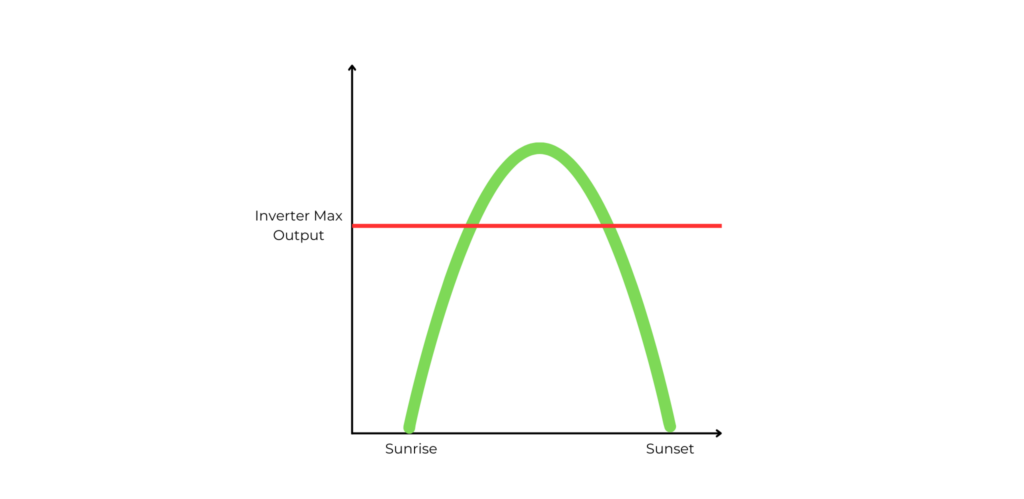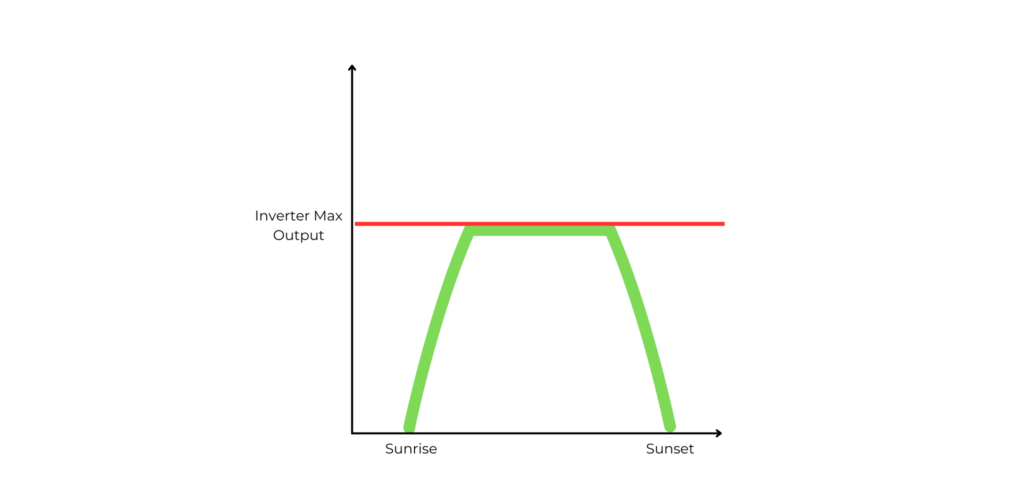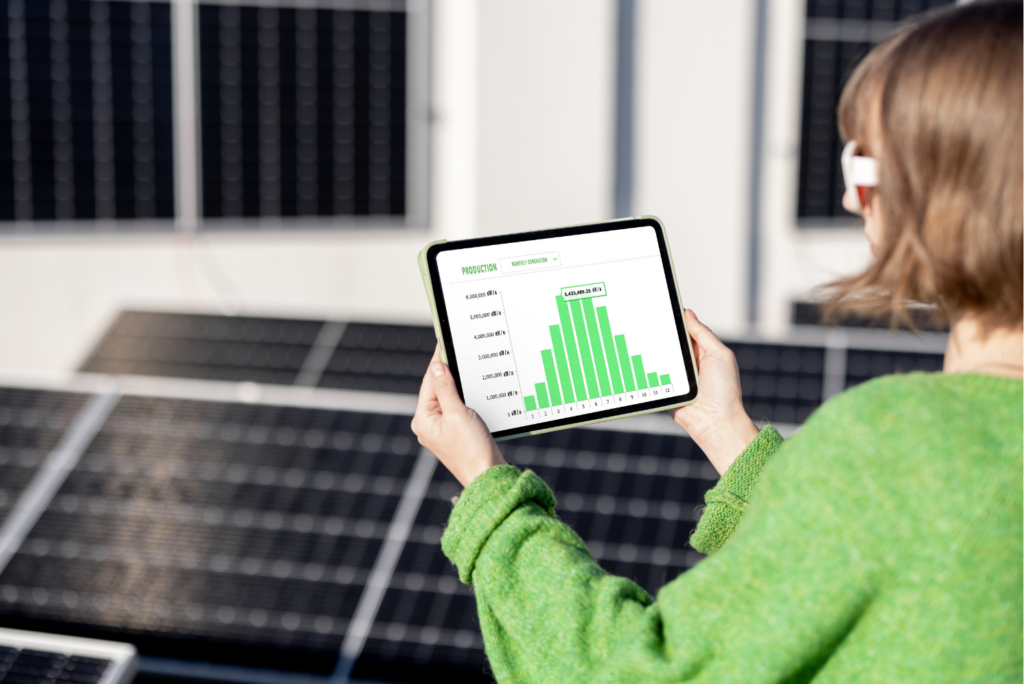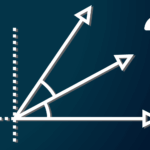A quick search online about solar equipment and you’re likely to run into the phrase “clipping”. Depending on who or which company you ask, you may get different interpretations of clipping and how it affects your solar system’s performance.
Let’s look at what clipping is, why it happens, and what impact it has on solar energy systems.
Table of Contents
Excess Solar Energy
Clipping refers to potential solar energy loss when panel production exceeds the maximum inverter output. Outside of off-grid systems and direct DC applications, solar energy must be run through an inverter before it can be used in a home.
When sunlight hits a solar panel, the panel produces electricity in direct current (DC). That current is fed via wiring to an inverter, where it is converted into alternating current (AC) and then sent into the home for consumption.
Inverters are only capable of certain power output levels, which are highlighted on their datasheets. If the maximum output of the inverter has been reached but the panels are still pumping energy toward it, that extra power is lost.
Think of your inverter as a pipe; if more water tries to flow through it than the pipe can handle, the excess water gets blocked and can’t pass through.

Once solar production hits the inverter maximum, everything above that line is lost, leading to a production curve that flattens out at the top:

What Conditions Cause Clipping?
Clipping isn’t an “always on” or “always off” phenomenon. Clipping varies by season, day-to-day, and even hour-to-hour. Some installed systems will experience no clipping, and some experience very regular clipping.
Clipping is more often a product of how the solar array was designed and installed than anything else.
Solar panels are rated for certain amounts of energy production (300W, 400W, etc) but rarely hit their max production. Panels will produce the maximum amount of energy in the summertime, and that’s when clipping most often occurs. When designing a solar array with string inverters, installers generally try to size AC inverters roughly the same system’s DC size. With micro inverters, the panel size (W) affects which micro is chosen.
For example, if you installed 6 kW of solar panels, a 6 kW inverter would be commonly installed. Most manufacturers will recommend about 1.2 DC to AC oversizing for maximum efficiency. Some equipment will support higher levels of oversizing, but the higher the oversizing the more likely to have clipping.
Financial considerations are an important part of the clipping discussion, particularly regarding inverter upsizing and downsizing. Inverter manufacturers typically charge a premium for higher-capacity models, so opting for a larger inverter to reduce oversizing can increase project costs. Providers often justify the choice of a smaller inverter by pointing out that the savings from the lower cost outweigh any potential losses due to clipping.
The Effect Of Panel Direction
The direction solar panels face on a home will also drastically impact the amount of clipping the home experiences. For more information on the optimal direction of solar panels, check out our recent guide.
When panels all face one direction, sunlight hits them all at the same time, causing production to spike quickly. When production spikes like that, panel production can quickly reach the maximum inverter output capacity and initiate clipping.
Systems with panels on various roof planes facing different directions will have a smoother curve throughout the day, meaning they may never hit max inverter capacity. But avoiding clipping doesn’t mean you should purposefully move panels from a high-producing roof to a lower-producing one. The best way to avoid clipping is to properly size an inverter.
Inverter Differences
Depending on the type of inverter you have, you may not be able to see clipping happening. This is due to how the system is monitored.
With central inverter technologies with one inverter for the project, clipping can be seen as the graphs above illustrate- a parabolic curve that flattens out at the top. You likely won’t see a flat curve with a microinverter because the clipping happens at each panel.
Monitoring software shows the full system production curve, so when you view a central inverter monitoring, the clear maximum can be seen. The inverter is rated at 6 kW, and the curve flattens at 6 kW. Microinverter monitoring also shows the full system production curve, but to see clipping, you’d need to see the production curve of each panel/inverter individually.
The Overall Effect and What To Do About It

When you see clipping, the natural question is, “Is this bad for the equipment?” Most inverters can self-regulate when the PV array power exceeds the maximum input, meaning it adjusts the DC voltage and reduces the current going into the inverter. So, long story short, some clipping is unlikely to impact the longevity of your equipment. However, sustained and significant overdriving of equipment could reduce its useful life.
A solution for clipping is a battery, specifically a DC-coupled battery. DC-coupled batteries can bypass the input limitation and send excess power directly to the battery rather than lose it.
Overall, some clipping is nothing to worry about. Many solar arrays experience some clipping on a few sunniest days of the year. However, if you see clipping happening regularly outside of these peak sun days, you may want to talk with your solar provider about increasing the size of your inverter.
That being said, upsizing the inverter may not always be an option. If your home’s electric system can’t support a larger breaker you may have to accept some clipping to have the total power you want. A solar provider may charge more for an upsized inverter, so talk with your provider about the cost-benefit analysis before requesting it.



